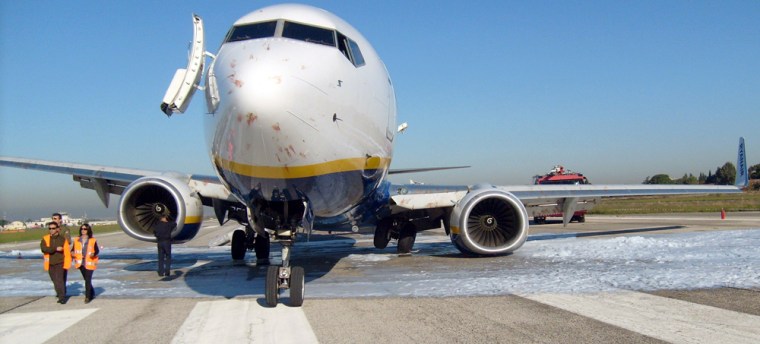Talk about unintended consequences. “Bird strikes” — or collisions between birds and aircraft — are increasing for two reasons, according to the federal government’s leading expert on the phenomenon: The environment is cleaner and airplanes are quieter.
While federal authorities have not confirmed initial reports that the US Airways jet that crashed Thursday in New York’s Hudson River hit a flock of birds shortly after taking off from LaGuardia airport, Dr. Richard A. Dolbeer told msnbc.com that such bird-aircraft collisions are on the rise.
"The key thing is that we’ve seen a remarkable increase in populations of many or most large birds — birds such as great blue heron, osprey, bald eagle, snow goose, Canada goose,” said Dolbeer, a retired ornithologist with the Department of Agriculture at the Wildlife Services in Sandusky, Ohio. "These populations are increasing because we’ve done a really good job of wildlife conservation in North America for many species, because we’ve cleaned up the environment, gotten rid of DDT, enacted the the Clean Water Act. All good things, but because of these, we’ve had incredible surges of many species that are hazardous to aviation.
"And at the same time, these species have adapted to being around people and all our activities. Related to that is the fact that modern jet aircraft, turbofan aircraft like the Airbus 320, the engines are very quiet. There’s very little noise out of the front of the airplane. Most of the noise is to the rear. There’s been a lot of attention paid to making the area around airports quieter. Birds have less ability to detect and avoid the aircraft.”
FAA statistics indicate that the number of aircraft bird strikes reported in the U.S. quadrupled from 1990 to 2007, rising from 1,738 per year to 7,439, These strikes caused 3,094 precautionary landings, 1,442 aborted takeoffs, 312 engine shutdowns and 1,162 minor negative effects, it said.
Worldwide, crashes of more than 25 large aircraft were caused by bird strikes since 1960, according to a published study by Dolbeer. In 23 of these incidents, the strike occurred below 400 feet. More than 219 people were killed and more than 200 aircraft destroyed in accidents attributed to bird strikes since 1988, Dolbeer and other researchers found.
In the U.S., most bird strikes happen between July and October, when bird populations are highest. But they can happen at any time of the year.
Using data from the FAA's National Wildlife Strike Database for Civil Aviation, he concluded that management of birds should focus on the airport environment. Most bird strikes happen on approach, less frequently on takeoff.
The threat from bird strikes has increased, Dolbeer found, because:
- The populations of many species of wild fowl commonly involved in strikes have increased markedly in the last few decades, and the birds have adapted to living in urban environments, including airports. For example, from 1980 to 2006, the resident (non-migratory) Canada goose population in the USA and Canada increased at an average rate of 7.3 percent per year.
- Air traffic has increased.
- Commercial airlines are replacing their older three- or four-engine aircraft fleets with more efficient and quieter two-engine aircraft, increasing the chance of a fatal incident because the plane has less backup power.
"As a result of these factors, experts within the Federal Aviation Administration (FAA), U.S. Department of Agriculture (USDA), and U.S. Air Force expect the risk, frequency, and potential severity of wildlife-aircraft collisions to grow over the next decade," Dolbeer reported.
Aviation authorities have attempted to reduce the risk of bird-strike accidents.
In 1960, after 62 people died when an Eastern Airlines plane went down after hitting a bird during takeoff from Boston Logan Airport, the FAA imposed bird-ingestion standards for turbine-powered engines.
